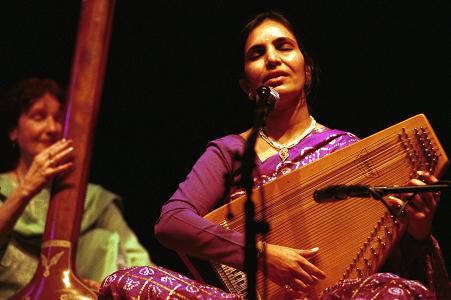 Singer takes instinctual path to ancient musical tradition. At its best, Indian classical music exerts a magical spell that can be meditative, mysterious and thrilling all in the same raga. Roger Levesque Updated: September 7, 2017 " When too much technique takes over you don’t enjoy your performance so much.” Renowned vocalist Shweta Jhaveri (who performs here Saturday) has been acclaimed for her seemingly effortless ability to improvise in concert, but for her, finding that magic involves taking a more instinctual suspension of thought. “Technique eventually takes a secondary part,” she explains, “and something else takes over. When too much technique takes over you don’t enjoy your performance so much.” She feels it comes down to a couple of special aspects, shruti and rasa. In a recent phone conversation from her home in California’s Bay Area she emphasized the two terms, both handed down from the ancient language of Sanskrit. “Shruti is the smallest interval in the microtonal form. Rasa is the sentiment, like the heart of the music. To me, these two are the major aesthetics in Indian classical music.” Just to clarify, a western chromatic scale divides into 12 pitches or semitones, the 12 notes on a piano. In the Indian classical tradition there are 22 microtones, thought to be the smallest changes in pitch noticeable to the human ear. Becoming comfortable with that microtonal scale and a range of complex time signatures are the greatest challenges in the life-long practice of Indian music. Whether they are destined to sing or play an instrument, Indian musicians commonly start by learning to create the microtonal scale vocally. Jhaveri started both voice and dance lessons at age six. Born in Ahmedabad in India’s northwest province of Gujarat, she is considered one of the top exponents in the North Indian tradition. She’s a master improviser in the extended suites known as raga, and in songs like the more uptempo, open-ended khayal form, the bhajan (devotional hymn), and thumri (romantic ballads). Most of her vocals are delivered in Hindi and she often accompanies herself strumming the zither-like string instrument known as swarmandal. Because Jhaveri’s father worked in medicine and her mother in literary pursuits she wonders if “something innate” drew her to music. “ My parents both have a great respect for classical arts including music so they were very supportive of my interests.” By the age of 16 she realized she had to choose vocal music or kathak dance and chose singing. By that time she was already composing her own songs and had been performing since age 11. In her early teens Jhaveri became a student of the great singer Pandit Jasrag and his style known as mewati. Accompanying him on tour took her throughout India and beyond to the west. At 18, she made her international debut in London and she has now enjoyed her own solo career over 20 years. Back in India she is featured regularly on radio and television and has contributed to film soundtracks, but she has a long career history in the Bay Area too. Jhaveri became the youngest visiting musician to join the faculty at the famous Ali Akbar College of Music in 1990, an association that lasted. Typically, the singer splits her year between the east and the west, her home in India and time in California. She is one of those rare virtuosos in the Indian classical world to crossover and Jhaveri has recorded with American jazz players using improvisation as a bridge between traditions. Jhaveri made her Edmonton concert debut in the late 1990s. Saturday’s concert for Raga Mala Music Society is her first appearance here in over a decade and she’s set to perform with veteran tabla percussionist Ravi Gutala, a colleague for nearly 30 years now. Edmonton Raga Mala presents Shweta Jhaveri at the Royal Alberta Museum Theatre, Saturday, 7 p.m. September, 2017 Edmonton, Canada |